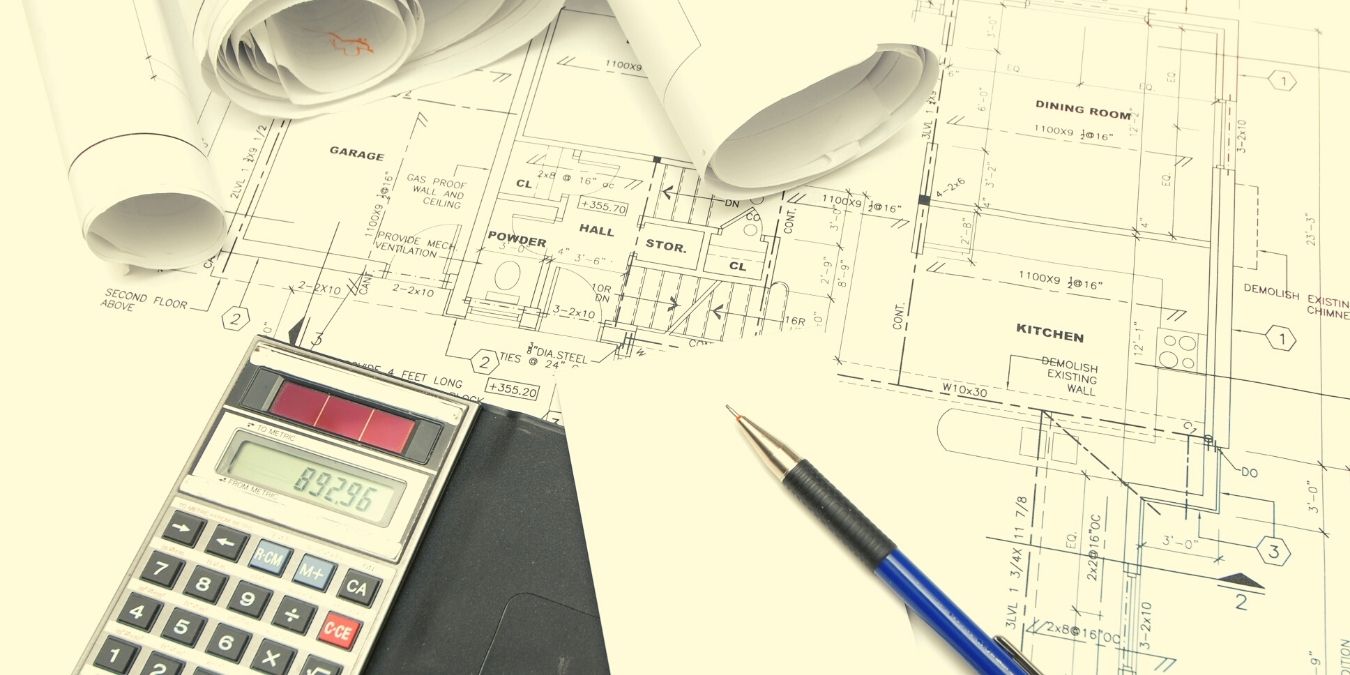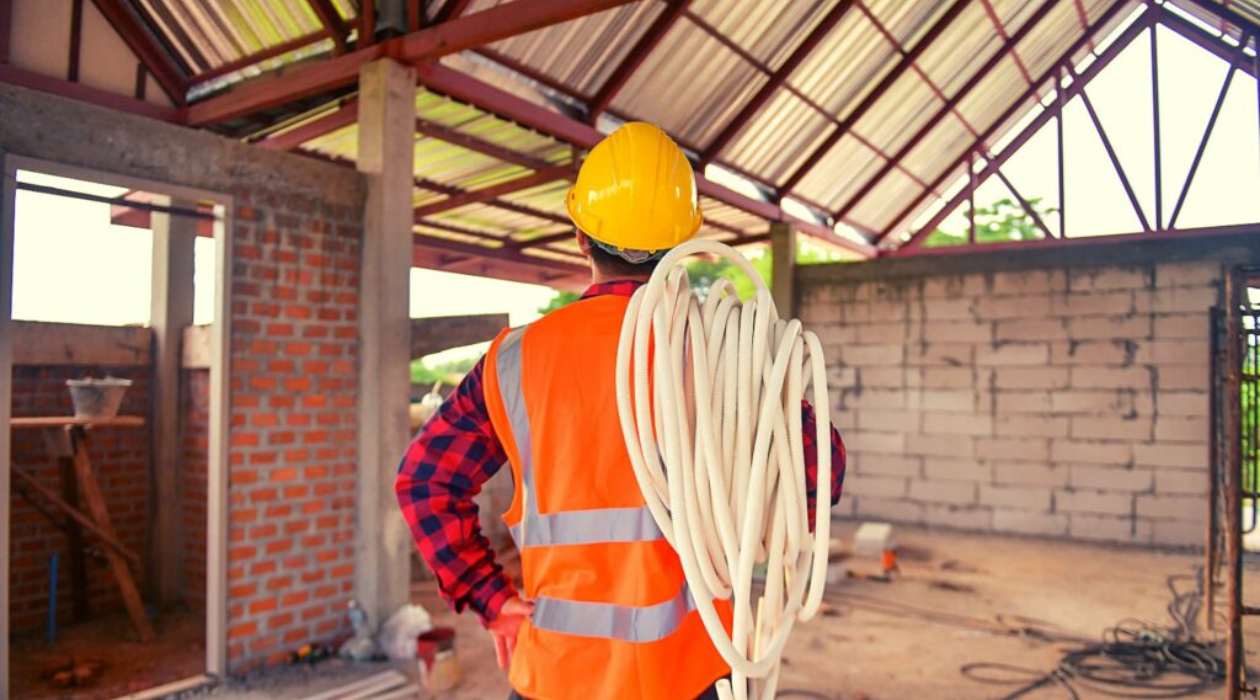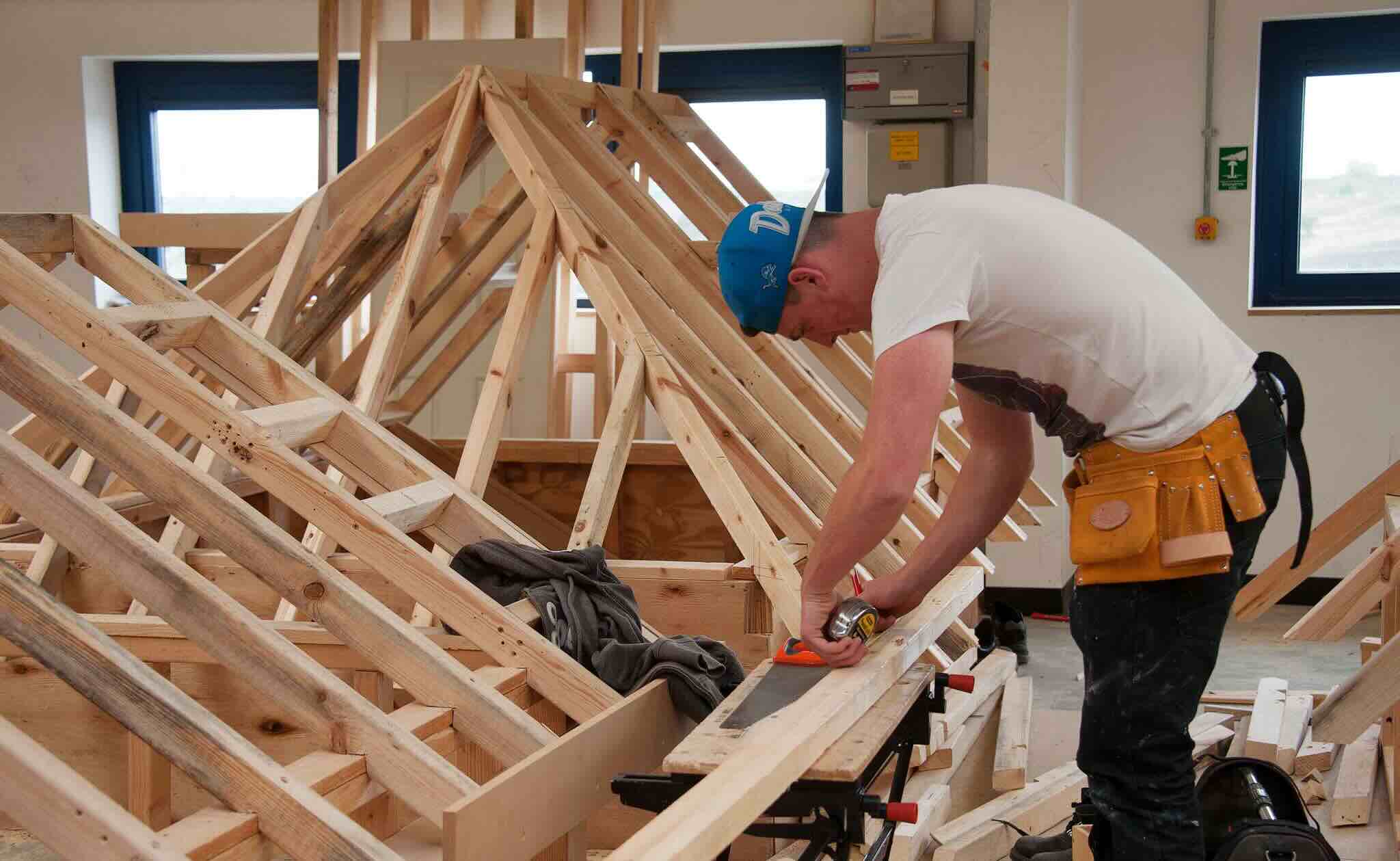Home>diy>Building & Construction>What Do Construction Estimators Do


Building & Construction
What Do Construction Estimators Do
Modified: January 4, 2024
Construction estimators play a crucial role in the building construction industry, providing accurate cost assessments and estimating project timelines. Learn more about their responsibilities and skills.
(Many of the links in this article redirect to a specific reviewed product. Your purchase of these products through affiliate links helps to generate commission for Storables.com, at no extra cost. Learn more)
Introduction
Welcome to the world of construction estimating! If you’ve ever wondered what construction estimators do, you’re in the right place. Construction estimators play a crucial role in the building industry, helping companies plan and budget for construction projects. They are the professionals responsible for determining the costs and resources required to complete a project successfully.
Construction estimating involves a combination of technical knowledge, analytical skills, and attention to detail. Estimators need to understand various construction disciplines, such as architecture, engineering, and project management. They also need to stay updated on industry trends, materials, and labor costs to provide accurate estimates.
In this article, we will delve into the key responsibilities of construction estimators, the skills they possess, and the tools they use to ensure accurate and efficient project estimation. Let’s begin exploring the fascinating world of construction estimating!
Key Takeaways:
- Construction estimators play a crucial role in accurately determining the costs involved in a construction project, requiring technical knowledge, attention to detail, and collaboration with stakeholders.
- Utilizing estimating software enhances the speed, accuracy, and efficiency of the cost estimation process, allowing construction estimators to generate detailed and reliable estimates.
Read more: What Is Estimating In Construction
Responsibilities of Construction Estimators
Construction estimators have a wide range of responsibilities that revolve around accurately determining the costs involved in a construction project. Let’s take a closer look at some of their key responsibilities:
- Reviewing project requirements: Estimators carefully review project specifications, plans, and contract documents to understand the scope and requirements of the project. This includes analyzing architectural and engineering drawings, project schedules, and any special conditions that may impact the cost estimation process.
- Cost estimating: Estimators use their knowledge and expertise to calculate the material, labor, and equipment costs needed to complete the project. They consider factors such as quantity take-offs, labor rates, material prices, equipment rental costs, and any additional expenses to generate an accurate cost estimate.
- Performing quantity take-offs: Estimators measure and quantify the materials and resources required for each element of the project. They calculate the quantities of items such as concrete, steel, lumber, roofing materials, and piping based on the project plans, ensuring that all components are accounted for in the cost estimation.
- Identifying subcontracting needs: Estimators assess the need for subcontractors and specialty trades based on the project specifications. They evaluate the scope of work and determine whether it is more efficient and cost-effective to subcontract certain portions of the project, such as electrical or plumbing work.
- Researching material and labor costs: Estimators keep up-to-date with current market prices of construction materials, as well as labor rates in the industry. This helps them ensure accurate cost estimations, taking into account fluctuations in market prices and regional variations.
- Providing cost breakdowns: Estimators create detailed cost breakdowns for each element of the project. This includes itemizing costs for materials, labor, equipment, permits, and any other expenses associated with the construction process. These breakdowns help project stakeholders understand the cost allocations and make informed decisions.
- Preparing bid proposals: Estimators play a vital role in the bidding process by preparing comprehensive and competitive bid proposals. They collaborate with other team members, such as project managers and engineers, to develop a compelling proposal that meets the client’s requirements while considering the company’s profit margin.
These are just some of the key responsibilities that construction estimators undertake in their day-to-day work. Their precision and expertise are essential for successful project planning and execution. Let’s now explore how they approach the process of estimating costs in more detail.
Estimating Costs
Estimating costs is a fundamental aspect of a construction estimator’s role. It involves determining the financial resources required to complete a construction project. Let’s take a closer look at the different factors that estimators consider when estimating costs:
- Material Costs: Estimators analyze the project plans and specifications to identify the types and quantities of materials required. They research current market prices and factor in the costs of materials such as concrete, steel, lumber, piping, electrical components, and finishing materials like paint and tiles.
- Labor Costs: Estimators evaluate the labor requirements for each phase of the project. They consider the number of workers needed, their skill levels, and the labor rates associated with each trade. Estimators also account for factors like unions, overtime, and other labor-related costs.
- Equipment Costs: Estimators assess the need for specific construction equipment and machinery on the project. They calculate the costs associated with equipment rental, fuel, maintenance, and depreciation. Estimators also account for any specialized equipment required for certain tasks.
- Subcontractor Costs: Depending on the project, estimators may need to evaluate and include costs associated with subcontractors or specialty trades. They analyze subcontractor bids or historical data to estimate the costs associated with specific subcontracted tasks.
- Permits and Licenses: Estimators factor in the costs of obtaining necessary permits and licenses for the project. They consider building permits, environmental permits, inspections, and any other regulatory requirements that may impact the project’s timeline and budget.
- Overhead and Contingency Costs: Estimators allocate a portion of the budget for indirect costs, including general overhead expenses such as office rent, insurance, utilities, and administrative staff salaries. They also include a contingency amount to account for unforeseen circumstances or changes in the project scope.
Estimators use a combination of historical data, industry knowledge, and specialized software tools to calculate these costs accurately. They continually refine and update their estimates as new information becomes available throughout the project lifecycle.
Next, let’s explore how construction estimators analyze project documents to gather the information needed for accurate cost estimation.
Analyzing Project Documents
Construction estimators rely heavily on project documents to gather the necessary information for accurate cost estimation. Analyzing project documents is a crucial step that allows estimators to understand the scope, requirements, and complexities of the construction project. Here are some key aspects that estimators focus on when analyzing project documents:
- Architectural and Engineering Drawings: Estimators carefully review architectural and engineering drawings to gain a comprehensive understanding of the project’s design and layout. They analyze the dimensions, materials, and specifications depicted in the drawings to determine the quantity of materials needed and identify any potential challenges or conflicts.
- Project Specifications: Estimators thoroughly examine the project specifications, which outline detailed requirements for materials, construction methods, and quality standards. They carefully consider the specified finishes, equipment, fixtures, and other essential components that impact the overall cost of the project.
- Bills of Quantities: Estimators refer to bills of quantities or scopes of work documents that break down the project into individual tasks or items. These documents provide a detailed list of materials, labor, and other resources required for each element of the project. Estimators use this information to calculate quantities and estimate costs accordingly.
- Contract Documents: Estimators carefully review all contract documents, such as the general conditions, special conditions, and contract specifications. These documents provide crucial information about contractual requirements, project schedules, payment terms, and other contractual obligations that need to be considered during the cost estimation process.
- Change Orders: If there are any change orders or modifications to the original project scope, estimators analyze these documents to understand the impact on cost and schedule. They evaluate the changes and adjust the cost estimation accordingly, ensuring that all revisions are accurately reflected in the final estimate.
- Value Engineering Suggestions: Estimators may also review value engineering suggestions or alternative design proposals. These suggestions aim to optimize the design and reduce costs without compromising quality or functionality. Estimators evaluate the feasibility and cost implications of these suggestions and incorporate them into the cost estimation process as needed.
Analyzing these project documents requires a keen eye for detail and a solid understanding of construction practices and methodologies. Estimators must extract the necessary information, identify potential cost-saving opportunities or challenges, and integrate all relevant details into their cost estimate.
Next, let’s explore how construction estimators gather and analyze data to support their cost estimation process.
Gathering and Analyzing Data
Gathering and analyzing data is a critical step in the construction estimating process. Estimators rely on accurate and up-to-date data to ensure the reliability of their cost estimations. Here are some key aspects of data gathering and analysis for construction estimators:
- Market Research: Estimators conduct market research to gather information on material prices, labor rates, and equipment costs. This involves contacting suppliers, subcontractors, and industry experts to stay informed about market trends and fluctuations. By analyzing this data, estimators can adjust their cost estimates based on the current market conditions.
- Historical Data: Estimators draw on historical data from previous construction projects to establish benchmarks and estimate costs. They analyze past projects of a similar nature, considering factors such as project size, complexity, location, and duration. This historical data allows estimators to make informed decisions and provide accurate cost estimates based on real-world experiences.
- Estimating Software: Estimators use specialized estimating software to streamline the data gathering and analysis process. These software tools allow them to store, organize, and analyze data effectively. They can input quantities, prices, and other project-specific information to generate detailed estimates quickly and accurately.
- Subcontractor and Supplier Bids: Estimators obtain bids from subcontractors and suppliers for specific elements of the project. They analyze these bids to gather pricing information, evaluate the quality of work offered, and confirm availability. This data helps estimators establish accurate costs for subcontracted work and material supply.
- Labor Productivity Analysis: Estimators analyze labor productivity rates to estimate the time and labor costs required for specific project tasks. They consider factors such as the skills of the labor force, average work speed, and potential inefficiencies or delays that may impact productivity. By analyzing labor productivity data, estimators can accurately determine the labor costs associated with each project phase.
- Local Requirements and Regulations: Estimators gather data on local requirements and regulations that may impact the project costs. They analyze building codes, zoning regulations, permit fees, and any other legal requirements that may affect the construction process. This data allows estimators to account for all necessary expenses associated with compliance.
Gathering and analyzing data in construction estimating requires a combination of research, industry knowledge, and technological tools. Estimators meticulously collect, organize, and evaluate data to ensure that their cost estimates are as accurate and comprehensive as possible.
Next, let’s explore how construction estimators create and present their estimates to clients and project stakeholders.
Construction estimators are responsible for calculating the costs of materials, labor, and equipment needed for a construction project. They should have a strong understanding of construction methods and materials to accurately estimate project costs.
Read more: How To Do An Estimate For Construction
Creating and Presenting Estimates
Creating and presenting estimates is a crucial aspect of a construction estimator’s role. A well-prepared and presented estimate helps clients and project stakeholders make informed decisions and plan their budgets effectively. Here are some key considerations when creating and presenting estimates:
- Accuracy and Detail: Estimators strive to provide accurate and detailed estimates that cover all aspects of the project. They ensure that quantities, prices, and costs are calculated meticulously, taking into account all materials, labor, equipment, subcontractor fees, permits, and other project-related expenses. Estimators use their expertise and estimating software to generate precise estimates that reflect the project’s requirements.
- Clarity and Understanding: Estimators communicate the estimate in a clear and understandable manner. They explain complex terms and technical details in plain language so that clients and stakeholders can easily comprehend the breakdown of costs. Estimators may include visual aids, such as charts, graphs, or diagrams, to enhance understanding and provide visual representations of the estimate.
- Written Documentation: Estimators prepare written documentation that outlines the estimate in detail. This may include a project summary, cost breakdowns, material and labor quantities, subcontractor quotes, and any assumptions or exclusions made during the estimation process. The documentation serves as a comprehensive reference for stakeholders to review and discuss before making decisions.
- Professionalism and Presentation Skills: Estimators present the estimate to clients and stakeholders in a professional manner. They may conduct meetings or presentations where they explain the estimate, answer questions, and address any concerns or clarifications. Estimators have strong communication and presentation skills to effectively convey the information and build trust with the stakeholders.
- Value Engineering Recommendations: Estimators may provide value engineering recommendations to clients, suggesting alternative construction methods, materials, or design options that can optimize costs without compromising quality. They highlight any potential cost-saving opportunities or efficiencies that can benefit the project, ensuring that clients have a comprehensive understanding of all available options.
- Flexibility and Adaptability: Estimators understand that cost estimates may need to be adjusted as project plans evolve or change. They remain flexible and adaptable, revising and updating the estimate as required. Estimators communicate these changes promptly and transparently to stakeholders, ensuring that they are aware of any fluctuations in costs and timelines.
Creating and presenting estimates requires a combination of technical skills, communication abilities, and attention to detail. It is through the estimator’s expertise and professionalism that clients and stakeholders gain confidence in the accuracy and validity of the estimate.
Next, let’s explore the importance of collaboration with project stakeholders in the construction estimating process.
Collaboration with Project Stakeholders
Collaboration with project stakeholders is paramount for construction estimators to ensure accurate and successful cost estimation. Effective collaboration allows estimators to gather valuable insights, understand project requirements, and address any concerns or challenges. Here are key aspects of collaboration with project stakeholders:
- Engaging with Clients: Estimators work closely with clients to fully understand their vision and project goals. They actively listen to clients’ needs, preferences, and budget constraints to align the cost estimation with their expectations. Regular communication and collaboration with clients throughout the estimation process help build trust and establish a strong working relationship.
- Coordinating with Project Managers: Estimators collaborate with project managers to gain insights into the project scope, schedule, and resources. They work closely together to ensure the cost estimation aligns with the project plan, and any changes or adjustments are appropriately addressed. Regular coordination between estimators and project managers enables the smooth integration of cost estimates into overall project management.
- Consulting with Design Professionals: Estimators may consult with architects, engineers, and other design professionals to clarify project specifications and resolve any design-related cost implications. By collaborating with design professionals, estimators ensure that the cost estimation accurately reflects the project’s design intent while considering practicality and cost-effectiveness.
- Involving Subcontractors and Suppliers: Estimators collaborate with subcontractors and suppliers throughout the estimation process. They consult with subcontractors to gather accurate quotes and understand their capabilities. Estimators also engage with suppliers to obtain material prices and availability. Collaboration with subcontractors and suppliers helps estimators make informed decisions and ensure that all aspects of the project are accounted for in the cost estimation.
- Seeking Expert Advice: Estimators may seek expert advice from industry professionals, consultants, or specialized trades to gain insights into specific aspects of the project. Expert input can help estimators assess unique challenges, provide alternative approaches, or validate cost estimates. Collaboration with experts expands the estimator’s knowledge and expertise in specific areas of construction.
- Addressing Stakeholder Concerns: Estimators actively address stakeholder concerns or questions related to the cost estimation. They provide clear explanations, clarify assumptions, and address any discrepancies to ensure that all stakeholders have a complete understanding of the estimate. Open communication and the willingness to address concerns foster trust and confidence in the estimation process.
Collaboration with project stakeholders allows estimators to gain valuable insights, enhance the accuracy of cost estimation, and ensure that the estimate aligns with the project’s goals and requirements. By fostering open communication and collaboration, estimators can contribute to a successful construction project.
Next, let’s explore the role of estimating software in the construction estimation process.
Utilizing Estimating Software
Estimating software has become an invaluable tool for construction estimators, streamlining the cost estimation process and enhancing accuracy. Estimators utilize specialized software to perform various tasks efficiently and effectively. Here are some key ways in which estimators utilize estimating software:
- Quantity Take-off: Estimating software allows estimators to perform accurate and detailed quantity take-offs by digitally measuring and counting elements from project drawings. This eliminates the need for manual calculations and reduces the potential for errors. Estimators can quickly generate quantities for materials, labor, and equipment, saving time and improving accuracy.
- Cost Database Management: Estimating software enables estimators to create and maintain comprehensive cost databases. These databases store current market prices for materials, labor rates, equipment costs, and subcontractor prices. Estimators can access this data easily and consistently incorporate it into their cost estimates, ensuring up-to-date and accurate pricing information.
- Cost Estimation Calculation: Estimators rely on estimating software to perform complex calculations required for cost estimation. The software automatically factors in quantities, rates, and other project-specific information to generate accurate cost estimations. This reduces the chances of manual calculation errors and provides estimators with consistent and reliable results.
- Cost Breakdown and Reporting: Estimating software allows estimators to generate detailed cost breakdowns and reports. Estimators can create customized reports that outline material quantities, labor costs, subcontractor costs, and other expense categories. These reports provide stakeholders with a clear and structured breakdown of costs, enhancing transparency and facilitating decision-making.
- Integration with other Software: Estimating software can seamlessly integrate with other project management software, such as scheduling tools and accounting systems. This integrated approach ensures data consistency across platforms, eliminates the need for manual data entry, and simplifies overall project management processes.
- Version Control and Collaboration: Estimating software allows multiple estimators to collaborate simultaneously on the same estimate. It provides version control features, enabling the tracking of changes, revisions, and updates made to the estimate. This facilitates seamless collaboration among team members and ensures that everyone is working with the most up-to-date information.
Utilizing estimating software enhances the speed, accuracy, and efficiency of the cost estimation process. Estimators can leverage the advanced features and capabilities of the software to produce detailed and reliable estimates, ultimately contributing to successful project planning and execution.
Next, we will explore the importance of continuous learning and professional development for construction estimators.
Continuous Learning and Professional Development
Continuous learning and professional development are crucial for construction estimators to stay at the top of their field and adapt to the evolving construction industry. Here are key reasons why continuous learning is important for construction estimators:
- Keeping Up with Industry Trends: The construction industry is continually evolving, with new technologies, materials, and practices emerging regularly. Continuous learning allows estimators to stay updated with the latest industry trends, ensuring that their cost estimations incorporate current best practices and methodologies.
- Understanding New Regulations and Codes: Construction regulations, building codes, and environmental standards are subject to change. Estimators must stay informed about these changes to accurately estimate costs associated with compliance. Continuous learning ensures that estimators are aware of the latest regulations, enabling them to provide accurate and compliant cost estimations.
- Adopting New Technologies: The construction industry is embracing digital transformation, and new technologies are shaping the way projects are planned and executed. Continuous learning allows estimators to explore and adopt new estimating software, 3D modeling tools, and other technological advancements that can enhance the accuracy and efficiency of cost estimation processes.
- Improving Estimating Skills: Continuous learning provides estimators with opportunities to improve their estimating skills. They can explore advanced estimation techniques, refine their quantity take-off skills, enhance their understanding of construction materials and labor, and learn new methodologies to improve accuracy and efficiency in cost estimation.
- Networking and Collaboration Opportunities: Continuous learning allows estimators to participate in industry events, conferences, and networking opportunities. These events provide a platform to connect with industry peers, share experiences, and learn from each other. Networking and collaboration with other estimators can lead to the exchange of best practices, insights, and innovative approaches in cost estimation.
- Enhancing Professional Competence: Continuous learning and professional development enhance the competence and credibility of estimators. By staying up-to-date with industry knowledge and skills, estimators demonstrate their commitment to delivering accurate cost estimates. This boosts their professional reputation and opens doors to new opportunities and career advancements.
Construction estimators can pursue continuous learning through various avenues, such as attending webinars, workshops, and training programs. They can also participate in professional organizations and obtain certifications that demonstrate their expertise in cost estimation.
By prioritizing continuous learning and professional development, construction estimators ensure that they are equipped with the knowledge, skills, and tools necessary to excel in their roles and contribute to the success of construction projects.
Now, let’s summarize the key points discussed in this article.
Conclusion
Construction estimators play a vital role in the building industry, providing accurate cost estimates that are essential for successful project planning and execution. Through their expertise, technical knowledge, and collaboration with project stakeholders, estimators ensure that clients and project teams have a clear understanding of the financial resources required for construction projects.
In this article, we explored the responsibilities of construction estimators, which include reviewing project requirements, estimating costs, performing quantity take-offs, and preparing bid proposals. We discussed how estimators analyze project documents to gather information and collaborated with stakeholders to ensure accurate and comprehensive cost estimates.
We also discussed the importance of utilizing estimating software, which enhances efficiency, accuracy, and collaboration in the estimation process. Estimators can leverage estimating software to perform quantity take-offs, manage cost databases, and generate detailed cost breakdowns and reports.
Moreover, we highlighted the significance of continuous learning and professional development for construction estimators. Continuous learning enables estimators to stay updated with industry trends, embrace new technologies, and enhance their estimating skills. It also provides networking and collaboration opportunities to learn from industry peers and improve professional competence.
Construction estimators have a critical role in ensuring that projects are planned and executed within defined budgets. Their attention to detail, analytical skills, and continuous learning contribute to the success of construction projects and the overall growth of the industry.
So, whether you’re a client looking to estimate the costs of a construction project or an aspiring estimator seeking to enter the field, understanding the valuable role that construction estimators play is key to achieving successful and cost-effective construction projects.
Frequently Asked Questions about What Do Construction Estimators Do
Was this page helpful?
At Storables.com, we guarantee accurate and reliable information. Our content, validated by Expert Board Contributors, is crafted following stringent Editorial Policies. We're committed to providing you with well-researched, expert-backed insights for all your informational needs.














0 thoughts on “What Do Construction Estimators Do”